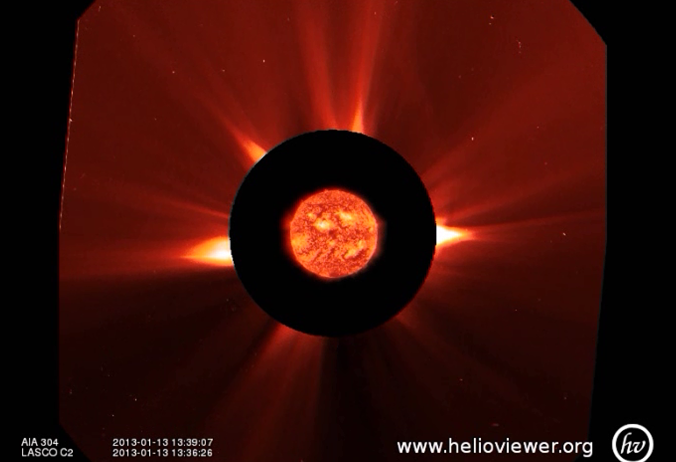In the Star Trek series, the Romulan empire disposes of an advanced technology that makes their spacecraft invisible. Using this stealth technology, they sneak up behind their unsuspecting enemies, suddenly revealing themselves and blowing the enemy spacecraft to smithereens.
A Coronal Mass Ejection (CME) used its own cloaking device to wreak geomagnetic havoc last Thursday, 17 January.
On 13 January, there were several CMEs on the Sun, but they seemed either weak or not directed towards Earth. This movie shows 2 CMEs between 09:00 and 15:00UT. The first CME seemed to be related to west limb activity and was directed away from Earth. The second CME was faint and slow (around 300 km/s), accompanying an impulsive M1.7-flare (peaking at 08:38UT) that originated in NOAA 1652. The plasma cloud was Earth-directed (as confirmed by STEREO) and expected to reach Earth late on 17 January, but it seemed too faint and slow to be geo-effective. The image underneath is a combination of SOHO/Lasco C2 coronagraph and SDO/AIA 304 imagery taken around 13:00UT and showing the faint CME to the north west (upper right).

As can be seen from the solar wind speed data, to a casual observer nothing abnormal seemed to be happening on 17 January. Solar wind was back at normal speeds after a coronal hole wind stream had passed by the Earth. In fact, the first small changes only start occurring around noon of 18 January.

The geomagnetic recordings tell a whole different story. Active geomagnetic conditions were observed in the afternoon of 17 January, and locally even minor storm conditions were recorded, e.g. at Dourbes.

Space weather forecasters are experienced observers, monitoring all solar wind parameters all the time. So, they quickly traced this geomagnetic activity to the passing of a CME by means of its telltale magnetic signature (ACE-graph underneath): A rather strong, mostly southwardly pointing magnetic field of the solar wind that changed its direction (phi-angle – see this STCE Newsletter) by 180 degrees in the course of a few hours. That’s an indication that the Earth and its magnetosphere were passing straight through the CME.

That this CME initially seemed to go unnoticed, was because it hitchhiked on the prevalent solar wind, gradually increasing from its slow initial speed to that of the solar wind. As a result, no shock (sudden increase in solar wind speed) was recorded when the CME passed by the Earth.
It really makes you wonder what those darn CMEs are up to next!
 |
 |





